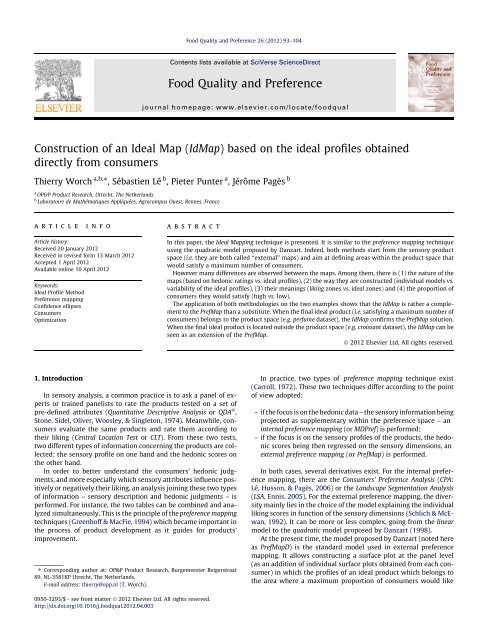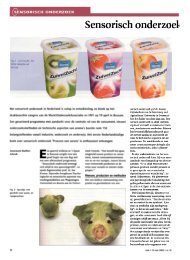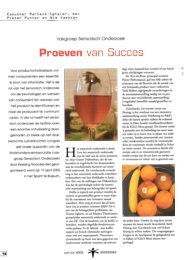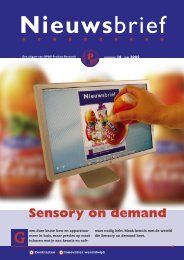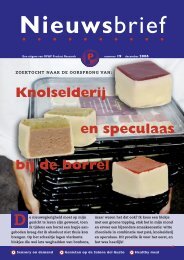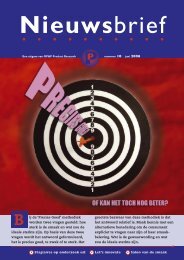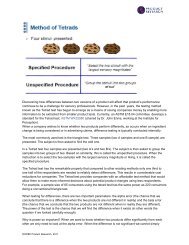Construction of an Ideal Map - OP&P Product Research
Construction of an Ideal Map - OP&P Product Research
Construction of an Ideal Map - OP&P Product Research
You also want an ePaper? Increase the reach of your titles
YUMPU automatically turns print PDFs into web optimized ePapers that Google loves.
Food Quality <strong>an</strong>d Preference 26 (2012) 93–104<br />
Contents lists available at SciVerse ScienceDirect<br />
Food Quality <strong>an</strong>d Preference<br />
journal homepage: www.elsevier.com/locate/foodqual<br />
<strong>Construction</strong> <strong>of</strong> <strong>an</strong> <strong>Ideal</strong> <strong>Map</strong> (Id<strong>Map</strong>) based on the ideal pr<strong>of</strong>iles obtained<br />
directly from consumers<br />
Thierry Worch a,b,⇑ , Sébastien Lê b , Pieter Punter a , Jérôme Pagès b<br />
a OP&P <strong>Product</strong> <strong>Research</strong>, Utrecht, The Netherl<strong>an</strong>ds<br />
b Laboratoire de Mathématiques Appliquées, Agrocampus Ouest, Rennes, Fr<strong>an</strong>ce<br />
article<br />
info<br />
abstract<br />
Article history:<br />
Received 20 J<strong>an</strong>uary 2012<br />
Received in revised form 13 March 2012<br />
Accepted 1 April 2012<br />
Available online 10 April 2012<br />
Keywords:<br />
<strong>Ideal</strong> Pr<strong>of</strong>ile Method<br />
Preference mapping<br />
Confidence ellipses<br />
Consumers<br />
Optimization<br />
In this paper, the <strong>Ideal</strong> <strong>Map</strong>ping technique is presented. It is similar to the preference mapping technique<br />
using the quadratic model proposed by D<strong>an</strong>zart. Indeed, both methods start from the sensory product<br />
space (i.e. they are both called ‘‘external’’ maps) <strong>an</strong>d aim at defining areas within the product space that<br />
would satisfy a maximum number <strong>of</strong> consumers.<br />
However m<strong>an</strong>y differences are observed between the maps. Among them, there is (1) the nature <strong>of</strong> the<br />
maps (based on hedonic ratings vs. ideal pr<strong>of</strong>iles), (2) the way they are constructed (individual models vs.<br />
variability <strong>of</strong> the ideal pr<strong>of</strong>iles), (3) their me<strong>an</strong>ings (liking zones vs. ideal zones) <strong>an</strong>d (4) the proportion <strong>of</strong><br />
consumers they would satisfy (high vs. low).<br />
The application <strong>of</strong> both methodologies on the two examples shows that the Id<strong>Map</strong> is rather a complement<br />
to the Pref<strong>Map</strong> th<strong>an</strong> a substitute. When the final ideal product (i.e. satisfying a maximum number <strong>of</strong><br />
consumers) belongs to the product space (e.g. perfume dataset), the Id<strong>Map</strong> confirms the Pref<strong>Map</strong> solution.<br />
When the final ideal product is located outside the product space (e.g. croiss<strong>an</strong>t dataset), the Id<strong>Map</strong> c<strong>an</strong> be<br />
seen as <strong>an</strong> extension <strong>of</strong> the Pref<strong>Map</strong>.<br />
Ó 2012 Elsevier Ltd. All rights reserved.<br />
1. Introduction<br />
In sensory <strong>an</strong>alysis, a common practice is to ask a p<strong>an</strong>el <strong>of</strong> experts<br />
or trained p<strong>an</strong>elists to rate the products tested on a set <strong>of</strong><br />
pre-defined attributes (Qu<strong>an</strong>titative Descriptive Analysis or QDA Ò ,<br />
Stone, Sidel, Oliver, Woosley, & Singleton, 1974). Me<strong>an</strong>while, consumers<br />
evaluate the same products <strong>an</strong>d rate them according to<br />
their liking (Central Location Test or CLT). From these two tests,<br />
two different types <strong>of</strong> information concerning the products are collected:<br />
the sensory pr<strong>of</strong>ile on one h<strong>an</strong>d <strong>an</strong>d the hedonic scores on<br />
the other h<strong>an</strong>d.<br />
In order to better underst<strong>an</strong>d the consumers’ hedonic judgments,<br />
<strong>an</strong>d more especially which sensory attributes influence positively<br />
or negatively their liking, <strong>an</strong> <strong>an</strong>alysis joining these two types<br />
<strong>of</strong> information – sensory description <strong>an</strong>d hedonic judgments – is<br />
performed. For inst<strong>an</strong>ce, the two tables c<strong>an</strong> be combined <strong>an</strong>d <strong>an</strong>alyzed<br />
simult<strong>an</strong>eously. This is the principle <strong>of</strong> the preference mapping<br />
techniques (Greenh<strong>of</strong>f & MacFie, 1994) which became import<strong>an</strong>t in<br />
the process <strong>of</strong> product development as it guides for products’<br />
improvement.<br />
⇑ Corresponding author at: OP&P <strong>Product</strong> <strong>Research</strong>, Burgemeester Reigerstraat<br />
89, NL-3581KP Utrecht, The Netherl<strong>an</strong>ds.<br />
E-mail address: thierry@opp.nl (T. Worch).<br />
In practice, two types <strong>of</strong> preference mapping technique exist<br />
(Carroll, 1972). These two techniques differ according to the point<br />
<strong>of</strong> view adopted:<br />
– if the focus is on the hedonic data – the sensory information being<br />
projected as supplementary within the preference space – <strong>an</strong><br />
internal preference mapping (or MDPref) is performed;<br />
– if the focus is on the sensory pr<strong>of</strong>iles <strong>of</strong> the products, the hedonic<br />
scores being then regressed on the sensory dimensions, <strong>an</strong><br />
external preference mapping (or Pref<strong>Map</strong>) is performed.<br />
In both cases, several derivatives exist. For the internal preference<br />
mapping, there are the Consumers’ Preference Analysis (CPA:<br />
Lê, Husson, & Pagès, 2006) or the L<strong>an</strong>dscape Segmentation Analysis<br />
(LSA, Ennis, 2005). For the external preference mapping, the diversity<br />
mainly lies in the choice <strong>of</strong> the model explaining the individual<br />
liking scores in function <strong>of</strong> the sensory dimensions (Schlich & McEw<strong>an</strong>,<br />
1992). It c<strong>an</strong> be more or less complex, going from the linear<br />
model to the quadratic model proposed by D<strong>an</strong>zart (1998).<br />
At the present time, the model proposed by D<strong>an</strong>zart (noted here<br />
as Pref<strong>Map</strong>D) is the st<strong>an</strong>dard model used in external preference<br />
mapping. It allows constructing a surface plot at the p<strong>an</strong>el level<br />
(as <strong>an</strong> addition <strong>of</strong> individual surface plots obtained from each consumer)<br />
in which the pr<strong>of</strong>iles <strong>of</strong> <strong>an</strong> ideal product which belongs to<br />
the area where a maximum proportion <strong>of</strong> consumers would like<br />
0950-3293/$ - see front matter Ó 2012 Elsevier Ltd. All rights reserved.<br />
http://dx.doi.org/10.1016/j.foodqual.2012.04.003
94 T. Worch et al. / Food Quality <strong>an</strong>d Preference 26 (2012) 93–104<br />
the product c<strong>an</strong> be estimated (D<strong>an</strong>zart, 2009; Mao & D<strong>an</strong>zart,<br />
2008).<br />
Although m<strong>an</strong>y external preference mapping studies involving<br />
all types <strong>of</strong> products have been published in the recent years (for<br />
a short review, see V<strong>an</strong> Kleef, V<strong>an</strong> Trijp, <strong>an</strong>d Luning (2006)), it is<br />
subject to m<strong>an</strong>y criticisms. Among them c<strong>an</strong> be mentioned (Faber,<br />
Mojet, & Poelm<strong>an</strong>, 2003):<br />
- only the two first sensory dimensions are used to explain the<br />
liking scores. Hence, some relev<strong>an</strong>t information is discarded,<br />
which c<strong>an</strong> lead to ‘‘irrelev<strong>an</strong>t’’ models for a non-negligible number<br />
<strong>of</strong> consumers;<br />
- adding extra dimensions in the circular, elliptic or quadratic<br />
models c<strong>an</strong> over-fit the liking scores. In this case, the optimization<br />
<strong>of</strong> the products c<strong>an</strong> be due to a small proportion <strong>of</strong> consumers<br />
only, as only a low number <strong>of</strong> degrees <strong>of</strong> freedom are<br />
available for the estimation <strong>of</strong> the parameters.<br />
Therefore, other multi-table <strong>an</strong>alyses such as Multiple Factor<br />
Analysis (MFA, Couronne, 1996; Esc<strong>of</strong>ier & Pagès, 2008), PLS<br />
regression (Husson & Pagès, 2003) or the L-PLS regression – when<br />
extra information concerning the consumers is available –<br />
(Lengard & Kermit, 2006) have been proposed.<br />
In this paper, we propose a variation <strong>of</strong> Pref<strong>Map</strong> when sensory<br />
data is collected according to the <strong>Ideal</strong> Pr<strong>of</strong>ile Method (IPM, Worch,<br />
2011; Worch, Lê, Punter, & Pagès, 2011). In this case, the consumers<br />
provide three types <strong>of</strong> information: the sensory pr<strong>of</strong>iles (i.e.<br />
how consumers perceive the products), the hedonic scores (i.e. how<br />
they like the products) as well as their ideal pr<strong>of</strong>iles (i.e. what are<br />
the consumers’ expectations). This technique takes into consideration<br />
the sensory pr<strong>of</strong>iles <strong>of</strong> the products <strong>an</strong>d the ideal pr<strong>of</strong>iles directly<br />
provided by consumers for the construction <strong>of</strong> the map.<br />
2. Materials <strong>an</strong>d methods<br />
2.1. Notation<br />
The same notation as the one used in the paper from Worch, Lê,<br />
Punter, <strong>an</strong>d Pagès (2012) checking for the consistency <strong>of</strong> the ideal<br />
data obtained from the IPM are used here. Hence, we denote in the<br />
rest <strong>of</strong> the article (the vectors are in bold):<br />
P: number <strong>of</strong> products tested;<br />
A: number <strong>of</strong> attributes used to describe the products tested as<br />
well as the ideal products;<br />
J: number <strong>of</strong> consumers.<br />
y jpa : intensity perceived by the consumer j for the product p <strong>an</strong>d<br />
the attribute a;<br />
y j,a ={y jpa ; p =1:P}: vector or intensities perceived by the<br />
consumer j for the P products <strong>an</strong>d the attribute a;<br />
Y j;a : average over the index p; average intensity perceived by<br />
the consumer j on attribute a over the P products. (Table 1)<br />
Z jpa : ideal intensity <strong>of</strong> the attribute a provided by the consumer<br />
j after testing the product p;<br />
Z j,a ={Z jpa ; p =1;P}: vector <strong>of</strong> ideal intensities <strong>of</strong> the attribute a<br />
provided by the consumer j for the P products;<br />
z j;a : average over the index p; average ideal intensity <strong>of</strong> the<br />
attribute a provided by the consumer j over the P products.<br />
h jp : hedonic judgment provided by the consumer j for the product<br />
p;<br />
H j ={h jp ; p =1:P}: vector <strong>of</strong> hedonic judgments provided by the<br />
consumer j for the P products.<br />
The difference between consumers related to a different use <strong>of</strong><br />
the scale is not <strong>of</strong> great interest here. The averaged ideal pr<strong>of</strong>ile<br />
from each consumer is hence corrected by subtracting, for each<br />
attribute, the averaged intensity that the consumer perceived for<br />
the entire set <strong>of</strong> products (Eq. 1). The corrected averaged ideal pr<strong>of</strong>ile<br />
is denoted ~z j .<br />
~z j;a ¼ z j;a<br />
y j;a ð1Þ<br />
Note: The term corrected refers to a geometric tr<strong>an</strong>slation <strong>of</strong> the<br />
ideal ratings according to the consumer’s use <strong>of</strong> the scale. It is performed<br />
in order to readjust all the consumers’ scales together. In<br />
other words, corrected refers to corrected for the scale use. In the rest<br />
<strong>of</strong> the document, we denote as corrected ideal pr<strong>of</strong>ile the ideal pr<strong>of</strong>ile<br />
from a consumer which has been corrected from the use <strong>of</strong> the<br />
scale using Eq. (1).<br />
2.2. Materials<br />
To illustrate the methodology presented below, two datasets<br />
obtained from the IPM are used: the perfume (Worch, Lê, & Punter,<br />
2010) <strong>an</strong>d the croiss<strong>an</strong>t datasets.<br />
Perfume: It concerns 12 luxurious women perfumes among<br />
which two were duplicated (Table 2). Each product has been rated<br />
on 21 attributes (listed in Table 2) by 103 Dutch consumers. For<br />
each perfume <strong>an</strong>d each attribute, both the perceived <strong>an</strong>d ideal<br />
intensities have been rated on a line scale. After rating each product<br />
on perceived <strong>an</strong>d ideal intensity, overall liking was rated on a<br />
structured 9-point category scale. The 14 samples were presented<br />
in monadic sequence, taking care <strong>of</strong> order <strong>an</strong>d carry-over effects<br />
(MacFie, Bratchell, Greenh<strong>of</strong>f, & Vallis, 1989) in two 1-h sessions.<br />
Croiss<strong>an</strong>t: Following the same procedure, nine croiss<strong>an</strong>ts have<br />
been tested by 151 Dutch consumers (Table 3). Each product has<br />
been rated on 26 attributes (Table 3). For confidentiality reasons,<br />
the product names <strong>an</strong>d their differences in the recipes will not<br />
be mentioned here.<br />
Table 1<br />
Org<strong>an</strong>ization <strong>an</strong>d illustration <strong>of</strong> the notation for the sensory data.<br />
Table 2<br />
List <strong>of</strong> products <strong>an</strong>d attributes in the perfume study. Note: the products Pure Poison<br />
<strong>an</strong>d Shalimar have been duplicated.<br />
<strong>Product</strong>s Type Attributes<br />
Angel Eau de Parfum Intensity Spicy<br />
Cinema Eau de Parfum Freshness Woody<br />
Pleasures Eau de Parfum Jasmine Leather<br />
Aromatics Elixir Eau de Parfum Rose Nutty<br />
Lolita Lempicka Eau de Parfum Chamomile Musk<br />
Ch<strong>an</strong>el No. 5 Eau de Parfum Fresh lemon Animal<br />
L’Inst<strong>an</strong>t Eau de Parfum V<strong>an</strong>illa Earthy<br />
J’Adore (EP) Eau de Parfum Citrus Incense<br />
J’Adore (ET) Eau de Toilette Anis Green<br />
Pure Poison Eau de Parfum Sweet fruit<br />
Shalimar Eau de Toilette Honey<br />
Coco Mademoiselle Eau de Parfum Caramel
T. Worch et al. / Food Quality <strong>an</strong>d Preference 26 (2012) 93–104 95<br />
Table 3<br />
List <strong>of</strong> products <strong>an</strong>d attributes in the croiss<strong>an</strong>t study.<br />
<strong>Product</strong>s Attributes<br />
Croiss<strong>an</strong>t 1 Length External color Butter taste<br />
Croiss<strong>an</strong>t 2 Height Internal color Overall taste<br />
Croiss<strong>an</strong>t 3 Bending Aroma <strong>of</strong> butter Sweetness<br />
Croiss<strong>an</strong>t 4 Shape Aroma overall Saltiness<br />
Croiss<strong>an</strong>t 5 Twist Crispiness Fatty taste<br />
Croiss<strong>an</strong>t 6 Consistency <strong>of</strong> shape Lamination Musty taste<br />
Croiss<strong>an</strong>t 7 Consistency <strong>of</strong> size Firmness Aftertaste intensity<br />
Croiss<strong>an</strong>t 8 Layers Moistness <strong>of</strong> crumb Aftertaste length<br />
Croiss<strong>an</strong>t 9 Gloss Chewiness<br />
2.3. Methods<br />
The construction <strong>of</strong> the <strong>Ideal</strong> <strong>Map</strong> is based on the methodology<br />
<strong>of</strong> the Pref<strong>Map</strong>D. Therefore, a comparison <strong>of</strong> results obtained from<br />
both methodologies is also presented.<br />
2.3.1. Id<strong>Map</strong><br />
2.3.1.1. Definition <strong>of</strong> the product space. Like for Pref<strong>Map</strong>D, the Id<strong>Map</strong><br />
takes as starting point the sensory product space. Thus, the Id<strong>Map</strong><br />
is defined as <strong>an</strong> external map which is directly comparable to<br />
Pref<strong>Map</strong>D.<br />
The product space is created from the averaged sensory pr<strong>of</strong>iles<br />
y p;a (Table 4a). It is obtained by multivariate <strong>an</strong>alysis (Principal<br />
Component Analysis, MFA, Generalized Procrustes Analysis, etc.). In<br />
this case, PCA is used.<br />
2.3.1.2. Projection <strong>of</strong> the corrected ideal products from each consumer<br />
<strong>an</strong>d <strong>of</strong> the liking scores on that space. In this product space, the corrected<br />
ideal products ~z jpa obtained from each consumer are projected<br />
as supplementary entities (Table 4b). The distribution <strong>of</strong><br />
the projection <strong>of</strong> these ideal products provides a first idea on the<br />
direction to take to develop <strong>an</strong> eventual ideal product satisfying<br />
a maximum <strong>of</strong> consumers (Fig. 1).<br />
2.3.1.3. Creation <strong>of</strong> the Id<strong>Map</strong> as a density map. To create the Id<strong>Map</strong>,<br />
a first solution consists in measuring the density <strong>of</strong> points (i.e. ideal<br />
products) projected in each zone <strong>of</strong> the space (Fig. 2).<br />
However, the low density <strong>of</strong> points projected (PxJ for full designs)<br />
does not allow the creation <strong>of</strong> a map which would be as<br />
precise as the one obtained with Pref<strong>Map</strong>D. Indeed, a high resolution<br />
(i.e. square the space in a high number <strong>of</strong> small zones) only<br />
Table 4<br />
Org<strong>an</strong>ization <strong>of</strong> the data used for the definition <strong>of</strong> the sensory space (a) with projection <strong>of</strong> the corrected ideal pr<strong>of</strong>iles as supplementary entities (b), <strong>an</strong>d <strong>of</strong> the liking scores as<br />
supplementary variables (c).<br />
Dim 2 (26.14%)<br />
-20 -10 0 10 20 30<br />
-40<br />
-20<br />
0<br />
20<br />
40<br />
Dim 1 (45.41%)<br />
Fig. 1. Projection <strong>of</strong> the corrected ideal products provided from the consumers on the sensory product space.
96 T. Worch et al. / Food Quality <strong>an</strong>d Preference 26 (2012) 93–104<br />
Fig. 2. <strong>Ideal</strong> <strong>Map</strong> obtained based on the density <strong>of</strong> ideal products projected in each zone <strong>of</strong> the space.<br />
associates each individual zone with a very small number <strong>of</strong> projections<br />
while a low resolution (i.e. squaring the space in a lower<br />
number but wider zones) creates a ‘‘gross’’ map.<br />
Moreover, this procedure does not take into account import<strong>an</strong>t<br />
information concerning the variability <strong>of</strong> the ideal pr<strong>of</strong>iles provided<br />
by the same consumer. Indeed, the Id<strong>Map</strong> created based on<br />
the density does not consider the origin <strong>of</strong> the projections: in this<br />
case, no difference is made whether the ideal products in a same<br />
zone are provided by one or m<strong>an</strong>y consumers.<br />
Let’s consider 100 consumers providing 10 ideal pr<strong>of</strong>iles each.<br />
One thous<strong>an</strong>d points are hence projected on this map. An ideal<br />
product belonging to a zone <strong>of</strong> the space regrouping 10% <strong>of</strong> the<br />
projections c<strong>an</strong> either be linked to a large number <strong>of</strong> consumers<br />
(one point per consumer), or to a small number <strong>of</strong> consumers<br />
(the 10 ideal pr<strong>of</strong>iles <strong>of</strong> 10 consumers). In these cases, the impact<br />
is not the same since the creation <strong>of</strong> such ideal product will not affect<br />
the same population (100 vs. 10 consumers).<br />
2.3.1.4. Smoothing procedure: use <strong>of</strong> confidence ellipses around the<br />
averaged ideal products. In order to take into account the variability<br />
within consumers <strong>of</strong> their ideal ratings, a confidence ellipse is constructed<br />
around the averaged ideal pr<strong>of</strong>ile provided by each consumer<br />
(Husson, Lê, & Pagès, 2005). These confidence ellipses are<br />
obtained by partial bootstrap on the products tested.<br />
In practice, a r<strong>an</strong>dom sampling with replacement <strong>of</strong> P 0 among<br />
the P tested products is performed (usually, P 0 is equal to P). For<br />
each consumer, the corrected ideal pr<strong>of</strong>ile averaged over the P 0<br />
products is computed <strong>an</strong>d projected as illustrative on the sensory<br />
space. This corresponds to <strong>an</strong>swering the following question:<br />
‘‘where the corrected averaged ideal product <strong>of</strong> a consumer would<br />
be projected if, instead <strong>of</strong> rating it according to the P products, he<br />
would rate it according to the P 0 products?’’<br />
This simulation step is iterated m<strong>an</strong>y times (500 times in practice)<br />
<strong>an</strong>d the confidence ellipses containing 95% <strong>of</strong> the projections<br />
are constructed around each consumer (Fig. 3).<br />
Note: In this situation, the consumers are associated to one unique<br />
ideal pr<strong>of</strong>ile that they described P times with a certain variability<br />
highlighted by the confidence ellipses. When the products<br />
tested are from different categories (e.g. milk <strong>an</strong>d dark chocolate),<br />
consumers might provide multiple ideals. In such situation, the Id-<br />
<strong>Map</strong> should be performed on the larger subset <strong>of</strong> products corresponding<br />
to one unique ideal.<br />
Dim 2 (26.14%)<br />
-15 -10 -5 0 5 10 15<br />
-10 -5 0 5 10 15 20<br />
Dim 1 (45.41%)<br />
Fig. 3. Confidence ellipses constructed around the corrected averaged ideal<br />
products from each consumer.<br />
For each point <strong>of</strong> the sensory space, the amount (in percentage)<br />
<strong>of</strong> ellipses covering that area is computed. In other words, for each<br />
point <strong>of</strong> the space, the proportion <strong>of</strong> consumers having <strong>an</strong> ideal in<br />
each area <strong>of</strong> the space is measured (Fig. 4).<br />
In order to facilitate the interpretation <strong>of</strong> the results, a color<br />
code is associated to each zone <strong>of</strong> the space: the larger the proportion<br />
<strong>of</strong> consumers in <strong>an</strong> area <strong>of</strong> the space, the lighter the color.<br />
2.3.1.5. Creation <strong>of</strong> the Id<strong>Map</strong>. Finally, the external <strong>Ideal</strong> <strong>Map</strong><br />
including contour lines associated with the proportion <strong>of</strong> consumers<br />
is constructed (Fig. 5).<br />
2.3.1.6. Notion <strong>of</strong> weight for the consumers. In theory, a large confidence<br />
ellipse me<strong>an</strong>s that the product is associated with a large variability.<br />
In our case, a large variability c<strong>an</strong> be interpreted in two<br />
ways:
T. Worch et al. / Food Quality <strong>an</strong>d Preference 26 (2012) 93–104 97<br />
Dim 2 (26.1%)<br />
-15 -10 -5 0 5 10 15<br />
1111 1000000 0000 000000000000 0000 00 11 111 1110 0000 000000000000 000<br />
1111 10 0 0 0 0 0 0 0 0 0 0 0 0 0 0 0 0 0 0 0 0 0 0 0 0 0 0 1 1 1 1 1 1 1 1 1 0 0000 000000000000 000<br />
1111 11 0 0 0 0 0 0 0 0 0 0 0 0 0 0 0 0 0 0 0 0 0 0 0 0 0 1111 111 1110 0000 000000000000 000<br />
1111 11 0 0 0 0 0 0 0 0 0 0 0 0 0 0 0 1 1 2 2 2 2 110 1 1 1 1 1 1 1 1 1 1 1 0 0000 000000000000 000<br />
1111 11 0 0 0 0 0 0 0 0 0 0 0 0 0 0 11222222221 1 1 1 1 1 1 1 1 1 0 0 0 0 0 0 0 0 0 0 0 0 0 0 0 0 0 0 0 0 0<br />
1111 11 0 0 0 0 0 0 0 0 0 0 0 0 0 1 1 1 222222222 1111 111 1000 0000 000000000000 000<br />
1111 11 0 0 1 1 1 1 0 0 0 0 0 0 111122222223 2 2 1 1 1 1 1 1 1 000 0000 000000000000 000<br />
1111 11 0 1111 1110 0 0 0 1112 2 2 2 2 2 2 2 3 2 2 2 11 110 0000 0000 000000000000 000<br />
1111 11 0 1111 1111 0 0 1 1 1 1 1 22222223 2 2 2 11 2 1 1 1 1 1 1 0 0 0 0 0 0 0 0 0 0 0 0 0 0 0 0 0 0 0<br />
1111 11 0 1111 1111 0 0 1 1 1 1 1 222222222223 2 2 2 1 1 1 1 1 1 1 1 0 000000000000 000<br />
1111 10 0 1111 1111 1 0 1 1 1 1 1 222222211 113 2 2 2 2 1111 1111 110 0 0 0 0 0 0 0 0 0 0 0 0<br />
1111 0 0 0 0 1 1 1 1 1 1 1 0 0 0 1112 2 3 3 3 3 3 2 11 13 3 2 2 2 2 1111 11 22 21110 0 0 0 0 0 0 0 0 0 0<br />
1110 0 0 0 0 0 11 1111 0 0 0 1 3 3 3 3 4 4 3 3 2222 1 2 3 2 2 2 2 1111 12 2 2 2 2 1 1 1 1 0 0 0 0 0 0 0 0 0<br />
110 0 0 0 0 0 0 0 0 0 0 0 0 0 0 0 223333 442 2 2 2 2 3 2 3 2 2 2 3 3 3 3 2 3 2 2 2 2 2 2 111100000000<br />
0000 0000000 0000 001 22222223 2 2 2 2 3 3 3 1 2 2 2 4 3334 4 3 3 2 2 2 2 111111000 000<br />
0000 0000000 0000 001 33333333 1 2223 3 3 2 3 223 3 3 3 4 4 4 33 32211111110 0 0 0 0<br />
0 0 0 0 0 0 0 0 0 0 0 0 0 0 0 0 1122333332 2 2 2 33 33 2 3 4 3 2 3344 4443 3 3 2 11111111 0 0 0 0<br />
0 0 0 0 0 0 0 0 0 0 0 0 0 0 0 0 0 1 22222223 4 4 4 5 4 4 5 33 34 3 3 4 5 4 4 4 4 4 3 3 2 1112 2 2 111 000<br />
0 0 0 0 0 0 0 0 0 0 0 0 0 0 0 0 0 2 2 4 4 4 223 4 4 4 5 77 665 4 4 5 4 5 6 6 6 5 4 4 4 4 3 2 112222 111 000<br />
0 0 0 0 0 0 0 0 0 0 0 0 0 0 1 1 1 2 3 4 4 4 334 6 7 6 7 88 9910 8 7 6 5 4 5 77 6 5 5 4 5 3 2 2 1 222221 1 1 0 0<br />
0001 1 1 1 0000 00 11 112 2 3 4443 777 78 8 9 911101110 9 8 5 4 5 7 7 6 6 5 5 3 2 2 1 222221 1 1 0 0<br />
0001 1 1 1 1 0 0 0 0 1 1 1 1 2222 3 5 667 9 9 88111111111111111110 9 7 7 6 7 8 8 6 6 4 2 2 1 222221 1 1 0 0<br />
0000 1 1 1 1 1 2 1 1 1 22 223 3 4 55881010111113131415151313141110111011 9 8888 6 6 3 3 2 2 2 2 2 2 1 1 1 0 0<br />
0000 1 1 1 1 2 2 2 1122 3 3 4 4 8 8111110131112141518191719181914121210101011 8 9 8 5 5 5 5 3 4 222221 1 000<br />
0000 01 2 333332 2 3 5 6 7 9 111515161618201821232322222120181817151514101112 9 8 7 5 5 5 3 4 4 2 3331 0 0 0 0<br />
0000 00 1 3344 44 6 7 10 9 101314192021232323252527272626252420201617161514101110 88 5 6 5 66443332 2 2 1 1<br />
0000 000 2 4 4 6 7778 9 111314172124242425262726302931323329232019181616161612111110 7 6 7 8 7 554442 2 2 2 1<br />
0000 00002 5 6 7778 101212152125272825262929313432343435342826201716201817141414131010 9 8 7 7 6 6 5 4 3 3 3 2 1<br />
0000 000 1 2 44 6 8 7 101213131421263232303031313434353635323329272120161618171415161513101010 9 8 6 6 5 5 4 3 3 3 1<br />
0000 00 1 1 2 3 4 5 6 7 1012121315232629333536373935353333313029262519191918151615151515131111 9997 665 4 4 332<br />
0000 01 1 1 1 2 3 668 9 11111315222727313237404239373434323227242019191919181716111416151210 8 9 8887 5 4 4 4 2 2<br />
0000 01 1 1 1 1 2 4 6 881010111721253034353841423837343530272625201819191818171413141413101010 8 9 8 8 7 7 4 4 3 2 2<br />
0000 01 1 1 1 1 1 337 8 1010121420232628323438433937373429272722201817161514151313121210 9 8 9 7 8 9 77663 3 2 2<br />
0000 01 1 1 1 1 1 334 5 6 9 1214182021232429323537363529252224222019161414121313121111 9 8887 7 6 6 6 6 5 4 222<br />
0000 01 1 1 1 1 1 1 3 44 5 5 7 1012172020232429323428262520212019201415121310101010 9 10 8 6 7 7 6 5 6 55442 2 2 1<br />
0000 01 1 1 1 1 1 1 1 44 45 6 7 8 101618191824273026252219211917171413151011111011 9 7 6 6 6 5 4 333333 2 2 2 2<br />
0000 00 1 1 1 1 1 1 1 1 4 4 4 4 6 8 991314161719192018171718181512121313 9 1111 9 10 9 6 6 6 4 332 3 3 3 3 3 2 2 2 2<br />
0000 000 1111 1111 2 3333 6 8 10121312101213141415161614111212 9 10 9 1010 9 66 5 5 5 33222221 1 1 1 1<br />
0000 00001 1 1 1 1 1 1 1 2 3 3 4 4 7 7 6 555 6 9 1111111111121111 7 7 7 7 8 8 8 6 5 4 4 4 2 1 1 1 1 1 1 1 1 1 1 1<br />
0 0 0 0 0 0 0 0 0 0 1 1 1 1 1 1 1 1 334 5 5 5 5 4 4 5 7 8 9 8889 10 8 8 7 6 7 8 6 5 7 5 4 4 4 111111111 111<br />
0 0 0 0 0 0 0 0 0 0 0 0 1 1 1 1 1 2 2 4 4 4 55444 5566 7 10 88 7 8 7 8 6 5 7 6 5 5 3 3 3 2 111111111 111<br />
0 0 0 0 0 0 0 0 0 0 0 0 0 0 0 0 113334 4 3 3 3 3 3 4 5 6 7777 77 6 554 5 6 5 44 2 11111111111 111<br />
0000 0000000 0000 0 1 2 2 2 2 1 2 3 3 3 3 3 4 4 4 5 8 8 7 888 5554 4 4 4 4 2 11111111111 111<br />
0 0 0 0 0 0 0 0 0 0 0 0 0 0 0 1 1 2 2 2 1111 333 33 44 5 6 77 776 6 6 6 5 3332 2 11111111111 111<br />
0 0 0 0 0 0 0 0 0 0 0 0 0 0 0 1 1 1 1 1 1 1 1 1 1 2 3 3 3 3 4 4 5 5 5 5 6 5 4443 1 2 2 2 2 2 1 1 1 1 1 1 1 1 1 1 1 1 1<br />
0 0 0 0 0 0 0 0 0 0 0 0 0 0 0 1 1 1 1 1 1 1 1 1 1 2 2 3333 34 5 4 333 2221 1 1 22 221 1 1 1 1 1 1 1 1 1 1 1 1<br />
0 0 0 0 0 0 0 0 0 0 0 0 0 0 0 1 1 1 1 1 1 1 1 1 1 1 1 2233 3332 2 2 2 1111 1112 2 2 1 1 1 1 1 1 1 1 1 1 1 1 1<br />
0 0 0 0 0 0 0 0 0 0 0 0 0 0 0 1 1 1 1 1 1 1 1 1 1 1 1 1 2 2 2 2 3 3 2 2 2 2 1111 1111 2 2 1 1 1 1 1 1 1 1 1 1 1 1 1<br />
0 0 0 0 0 0 0 0 0 0 0 0 0 0 0 1 1 1 1 1 1 1 1 1 1 1 1 1 1 1 2 2 2 2 2 2 2 2 1111 1111 1 2 1 1 1 1 1 1 1 1 1 1 1 1 1<br />
0 0 0 0 0 0 0 0 0 0 0 0 0 0 0 1 1 1 1 1 1 1 1 1 1 1 1 1 1 1 1 1 2 11 10 1 1 1 1 1 1 1 1 1 1 1 1 1 1 1 1 1 1 1 1 1 1 1 1<br />
0 0 0 0 0 0 0 0 0 0 0 0 0 0 0 1 1 1 1 1 1 1 1 1 1 1 1 1 1 1 1 1 1 00 000 0000 0000 001 1 1 1 1 1 1 1 1 1 1 1 1<br />
0 0 0 0 0 0 0 0 0 0 0 0 0 0 0 1 1 1 1 1 1 1 1 1 1 1 1 1 1 1 1 1 1 00 000 0000 0000 000 111111111 111<br />
0 0 0 0 0 0 0 0 0 0 0 0 0 0 0 0 11111111111 1111 10 0 0 0 0 0 0 0 0 0 0 0 0 0 0 0 0 0 0 1111111 111<br />
0 0 0 0 0 0 0 0 0 0 0 0 0 0 0 0 11111111111 1111 0000 000 0000 0000 0000001 1 1 1 1 1 1 1 1<br />
0 0 0 0 0 0 0 0 0 0 0 0 0 0 0 0 0 1 1 1 1 1 1 1 1 1 1 1 1 1 1 0000 000 0000 0000 0000000 11111111<br />
0 0 0 0 0 0 0 0 0 0 0 0 0 0 0 0 0 0 111111111 1110 0000 000 0000 0000 000000001 1 1 1 1 1 1<br />
0 0 0 0 0 0 0 0 0 0 0 0 0 0 0 0 0 0 0 1 1 1 1 1 1 1 1 1 000 0000 000 0000 0000 000000000 111 111<br />
0 0 0 0 0 0 0 0 0 0 0 0 0 0 0 0 0 0 0 0 0 1 1 1 1 1 0 0000 0000 000 0000 0000 00000000001 1 1 1 1<br />
0 0 0 0 0 0 0 0 0 0 0 0 0 0 0 0 0 0 0 0 0 0 0 0 0 0 0 0 0 0 0 0 0 0 0 0 0 0 0 0 0 0 0 0 0 0 0 0 0 0 0 0 0 0 0 0 0 1 1 1 1<br />
0 0 0 0 0 0 0 0 0 0 0 0 0 0 0 0 0 0 0 0 0 0 0 0 0 0 0 0 0 0 0 0 0 0 0 0 0 0 0 0 0 0 0 0 0 0 0 0 0 0 0 0 0 0 0 0 0 0 0 1 1<br />
0 0 0 0 0 0 0 0 0 0 0 0 0 0 0 0 0 0 0 0 0 0 0 0 0 0 0 0 0 0 0 0 0 0 0 0 0 0 0 0 0 0 0 0 0 0 0 0 0 0 0 0 0 0 0 0 0 0 0 0 1<br />
-10 -5 0 5 10 15 20<br />
Dim 1 (45.4%)<br />
Fig. 4. Proportion <strong>of</strong> consumers sharing a common ideal for each point <strong>of</strong> the<br />
sensory space.<br />
Dim 2<br />
-6 -4 -2 0 2 4 6 8<br />
3<br />
1<br />
7<br />
20<br />
2<br />
15<br />
6<br />
-5 0 5 10 15<br />
Dim 1<br />
Fig. 5. <strong>Ideal</strong> <strong>Map</strong> including contour lines indicating the proportion <strong>of</strong> consumers.<br />
- the consumer considered is associated with a large ideal area;<br />
- the consumer considered has difficulties rating stable ideals.<br />
In practice, it is impossible defining a threshold above which a<br />
confidence ellipse would be considered as large as well as determining<br />
the reason <strong>of</strong> this variability. However, a consumer associated<br />
with a large (vs. small) confidence ellipse has a stronger<br />
influence (resp. lower) in the construction <strong>of</strong> the Id<strong>Map</strong>. Indeed, a<br />
larger (resp. smaller) area <strong>of</strong> the sensory space is covered.<br />
For that reason, it might be worthwhile homogenizing consumers.<br />
To do so, each consumer is associated with a weight which is<br />
inversely proportional to the size <strong>of</strong> its corresponding ellipse. Each<br />
weighted consumer is thus associated with <strong>an</strong> ellipse <strong>of</strong> area equal<br />
to one unit which is spread on the sensory space:<br />
5<br />
30<br />
10<br />
25<br />
4<br />
15<br />
15<br />
10<br />
- a consumer rating stable ideal intensities (hence associated<br />
with a small ellipse) has a strong weight on each point <strong>of</strong> the<br />
small surface it covers;<br />
- a consumer rating large ideal intensities (hence associated with<br />
a large ellipse) has a small weight on each point <strong>of</strong> the wide surface<br />
it covers.<br />
The map thus obtained is noted weighted <strong>Ideal</strong> <strong>Map</strong> or wId<strong>Map</strong>.<br />
In this case, the contour lines do not correspond to the raw proportion<br />
<strong>of</strong> consumers, but to a corrected proportion according to<br />
the different consumers’ weights.<br />
If one assumes that large confidence ellipses correspond to consumers<br />
with wide ideal area, the use <strong>of</strong> the Id<strong>Map</strong> is recommended.<br />
However, if one assumes that wide ellipses correspond to instability<br />
<strong>of</strong> the ideal ratings, the wId<strong>Map</strong> is preferred.<br />
2.3.1.7. Definition <strong>of</strong> the ideal product. For the Pref<strong>Map</strong>D, the coordinates<br />
corresponding to the maximum proportion <strong>of</strong> consumers<br />
overlapping c<strong>an</strong> be extracted. By using the inverse formula from<br />
the PCA – which aims at estimating the sensory pr<strong>of</strong>ile <strong>of</strong> a product<br />
based on the coordinates on the map – a potential pr<strong>of</strong>ile <strong>of</strong> the<br />
ideal product c<strong>an</strong> be estimated based on these coordinates.<br />
This procedure c<strong>an</strong> also be applied to the Id<strong>Map</strong> technique. As<br />
the individual ideal pr<strong>of</strong>iles are known, one could also use as ideal<br />
product the averaged ideal pr<strong>of</strong>ile calculated directly from the consumers<br />
sharing <strong>an</strong> ideal product in this area <strong>of</strong> the map.<br />
2.3.2. Comparison <strong>of</strong> the Id<strong>Map</strong> <strong>an</strong>d the Pref<strong>Map</strong>D<br />
Although both methodologies (Id<strong>Map</strong> <strong>an</strong>d the Pref<strong>Map</strong>D) are<br />
similar, the nature <strong>of</strong> the data involved differs. And it is especially<br />
according to this difference that both techniques are compared.<br />
2.3.2.1. Link between the maps (a priori). According to Worch et al.<br />
(2012), a consumer is consistent if the ideal product provided<br />
shares similar characteristics with the preferred product.<br />
Thus, in the sensory space, the projection as illustrative <strong>of</strong> the<br />
ideal pr<strong>of</strong>iles provided by a consumer must be close to the preferred<br />
product. To check that, the corrected ideal pr<strong>of</strong>iles <strong>of</strong> the<br />
consumers (Table 4b) on one h<strong>an</strong>d <strong>an</strong>d the hedonic scores on the<br />
other h<strong>an</strong>d (Table 4c) are, respectively, projected as supplementary<br />
entities <strong>an</strong>d supplementary variables on the sensory space (Table<br />
4a). For a p<strong>an</strong>el composed <strong>of</strong> consistent consumers, the distribution<br />
<strong>of</strong> the consumers within the correlation circle (hedonic) is<br />
coherent (i.e. going in the same direction) with the distribution<br />
<strong>of</strong> the projections <strong>of</strong> their ideal pr<strong>of</strong>iles within the sensory space.<br />
This double projection provides a first visual impression about<br />
the relationship between Id<strong>Map</strong> <strong>an</strong>d Pref<strong>Map</strong>D. However, it is only<br />
approximate as the one to one relationship is not further studied<br />
here.<br />
2.3.2.2. Liking threshold <strong>an</strong>d definition <strong>of</strong> the Pref<strong>Map</strong>D <strong>an</strong>d Id<strong>Map</strong><br />
maps. In this study a product is defined as liked by a consumer if<br />
the consumer considered would like it more th<strong>an</strong> a certain threshold<br />
value. Similarly, each consumer is associated to <strong>an</strong> area <strong>of</strong> liking<br />
corresponding to the area <strong>of</strong> the sensory space which contains<br />
products he/she would like.<br />
The construction <strong>of</strong> the Pref<strong>Map</strong>D depends on the threshold value<br />
(also called liking threshold), as it determines whether a product<br />
belonging to the sensory space would be liked or not by each<br />
consumer.<br />
In practice, for a given consumer, each point <strong>of</strong> the space is<br />
associated with a product whose liking score is estimated based<br />
on a model defined for that consumer. This estimation <strong>of</strong> the liking<br />
score is compared to the liking threshold: if the estimation is larger<br />
(resp. smaller) th<strong>an</strong> the threshold, the product corresponding to<br />
this point <strong>of</strong> the space is liked (resp. rejected) by the consumer.
98 T. Worch et al. / Food Quality <strong>an</strong>d Preference 26 (2012) 93–104<br />
The larger the threshold, the smaller the surface <strong>of</strong> liking for<br />
each consumer. Thus, increasing the threshold reduces the ch<strong>an</strong>ces<br />
<strong>of</strong> overlap between individual areas <strong>of</strong> liking, hence reducing the<br />
proportion <strong>of</strong> consumers sharing a common ideal.<br />
In this paper, the st<strong>an</strong>dard threshold is considered for Pref<strong>Map</strong>D.<br />
It corresponds to the averaged hedonic rating h j each consumer<br />
provided to the products. In practice, this threshold me<strong>an</strong>s liking<br />
on average half <strong>of</strong> the product space for each consumer. Thus,<br />
the liking area defined for each consumer is wide <strong>an</strong>d is not defining<br />
a maximum-liking area for the st<strong>an</strong>dard Pref<strong>Map</strong>D.<br />
The use <strong>of</strong> such a threshold does not occur with the Id<strong>Map</strong>.<br />
However, it is possible to influence (to a lesser extent) the proportion<br />
<strong>of</strong> consumers sharing a common ideal by adjusting the size <strong>of</strong><br />
the individual confidence ellipses: the larger the individual ellipses,<br />
the higher the ch<strong>an</strong>ces <strong>of</strong> overlap. The size <strong>of</strong> the ellipses depends<br />
on several parameters:<br />
- the variability <strong>of</strong> the ideal pr<strong>of</strong>iles provided by a consumer;<br />
- the p-value used to create the ellipses (by default, the ellipses<br />
contain 95% <strong>of</strong> the projections, <strong>an</strong>d reducing this proportion<br />
reduces the size <strong>of</strong> the ellipse);<br />
- the number <strong>of</strong> products used for the resampling: increasing the<br />
number <strong>of</strong> products in the resampling procedure reduce the<br />
size <strong>of</strong> the ellipses;<br />
- at some extent, the application <strong>of</strong> weight to the ellipses as in the<br />
wId<strong>Map</strong>.<br />
In practice, the confidence ellipses cover only a small area <strong>of</strong> the<br />
product space. By definition, this liking area corresponds to<br />
(a)<br />
maximum liking (i.e. ideal product) for each consumer. Thus, we<br />
are talking about ideal area with the Id<strong>Map</strong>.<br />
The theoretical difference in the me<strong>an</strong>ings <strong>of</strong> the individual liking<br />
<strong>an</strong>d ideal areas in Pref<strong>Map</strong>D <strong>an</strong>d Id<strong>Map</strong> is related to the threshold<br />
used. This threshold as well as the surface <strong>of</strong> the area in each<br />
map are schematized Fig. 6.<br />
2.3.2.3. Comparison <strong>of</strong> the results through the estimated ideal pr<strong>of</strong>iles<br />
obtained. Besides the visual comparison <strong>of</strong> the maps obtained with<br />
the two techniques, one c<strong>an</strong> also compare the sensory pr<strong>of</strong>iles <strong>of</strong><br />
the ideal products both methods would generate.<br />
However, a one-to-one comparison <strong>of</strong> the ideal pr<strong>of</strong>iles might<br />
not be sufficient, as references are needed. To enrich the comparison,<br />
the sensory pr<strong>of</strong>iles <strong>of</strong> the tested products are added to the<br />
comparison. These sensory pr<strong>of</strong>iles are st<strong>an</strong>dardized on each attribute<br />
(Eq. 2a), <strong>an</strong>d the same tr<strong>an</strong>sformation is applied to the sensory<br />
pr<strong>of</strong>iles <strong>of</strong> the estimated ideal products (Eq. 2b).<br />
St<strong>an</strong>dardization <strong>of</strong> the sensory pr<strong>of</strong>iles <strong>of</strong> the tested products<br />
: ðy pa<br />
y a Þ=ry;a<br />
St<strong>an</strong>dardization <strong>of</strong> the sensory pr<strong>of</strong>iles <strong>of</strong> the ideal products<br />
: E pa<br />
y a =ry;a<br />
The P + 2 st<strong>an</strong>dardized products are represented graphically.<br />
(b)<br />
ð2aÞ<br />
ð2bÞ<br />
Density<br />
accept<strong>an</strong>ce threshold<br />
for Pref<strong>Map</strong>D<br />
Density<br />
accept<strong>an</strong>ce threshold<br />
for Id<strong>Map</strong><br />
Liking scores<br />
Liking scores<br />
Fig. 6. Theoretical difference in the ‘‘threshold’’ used to define the individual accept<strong>an</strong>ce area for Pref<strong>Map</strong>D (left, a) <strong>an</strong>d Id<strong>Map</strong> (right, b). Note: the arrow shows that for the<br />
Pref<strong>Map</strong>D, the accept<strong>an</strong>ce threshold c<strong>an</strong> be adjusted.<br />
Table 5<br />
Properties <strong>an</strong>d definition <strong>of</strong> the maps obtained with Pref<strong>Map</strong>D et Id<strong>Map</strong>.<br />
<strong>Ideal</strong> Pr<strong>of</strong>iles<br />
Pref<strong>Map</strong>D<br />
Indirect<br />
Globally estimated from <strong>an</strong> aggregation <strong>of</strong> individual data<br />
No possible validation<br />
Id<strong>Map</strong><br />
Direct<br />
Directly measured at the consumer level, <strong>an</strong>d then aggregated<br />
Direct validation through the study <strong>of</strong> the consistency <strong>of</strong> the individual<br />
data<br />
Extended product space (the individual ideal data c<strong>an</strong> be outside the<br />
product space)<br />
Space considered<br />
<strong>Product</strong> space only (the individual estimations belong to the<br />
product space)<br />
Interpretation issues Models: Ellipses:<br />
-Strong dependence to the individual models<br />
-Size: large ideal area or unstable ratings?<br />
-Low number <strong>of</strong> degrees <strong>of</strong> freedom<br />
-Homogenization <strong>of</strong> the ellipses? (use <strong>of</strong> individual weights)<br />
Proportion <strong>of</strong> consumers Mech<strong>an</strong>ic dependence to the threshold considered<br />
Mech<strong>an</strong>ic dependence to the size <strong>of</strong> the ellipses<br />
(contour lines)<br />
High when the threshold is low: there is a risk <strong>of</strong> finding Generally low by construction as it corresponds to a common ideal for<br />
Me<strong>an</strong>ings <strong>of</strong> the map<br />
unstable maxima<br />
Area <strong>of</strong> non-rejection (rather th<strong>an</strong> area <strong>of</strong> preference) when<br />
the threshold is low<br />
a group <strong>of</strong> consumers<br />
<strong>Ideal</strong> area for each consumer
T. Worch et al. / Food Quality <strong>an</strong>d Preference 26 (2012) 93–104 99<br />
2.3.2.4. Properties <strong>of</strong> the different maps. The properties <strong>of</strong> the different<br />
maps obtained according to Pref<strong>Map</strong>D <strong>an</strong>d Id<strong>Map</strong> are summarized<br />
Table 5.<br />
3. Results<br />
The methodology presented above is applied to the perfume <strong>an</strong>d<br />
to the croiss<strong>an</strong>t datasets.<br />
3.1. Measure a priori <strong>of</strong> the link between the maps<br />
The consistency <strong>of</strong> the ideal <strong>an</strong>d hedonic data is measured visually<br />
in the sensory space by projecting simult<strong>an</strong>eous the corrected<br />
ideal products from each consumer as supplementary entities <strong>an</strong>d<br />
the hedonic ratings as supplementary variables.<br />
In the perfume example, the projection <strong>of</strong> the hedonic ratings as<br />
supplementary variables highlights homogeneity <strong>of</strong> the p<strong>an</strong>el, the<br />
majority <strong>of</strong> consumers preferring the products located on the negative<br />
part <strong>of</strong> the first dimension (Fig. 7). Me<strong>an</strong>while, the projection<br />
<strong>of</strong> the corrected ideal products also suggests homogeneity <strong>of</strong> the<br />
p<strong>an</strong>el, the majority <strong>of</strong> the points being located along the negative<br />
part <strong>of</strong> the first dimension.<br />
In the croiss<strong>an</strong>t example, the projection <strong>of</strong> the hedonic ratings as<br />
supplementary variables highlights more heterogeneity th<strong>an</strong> in the<br />
perfume example (Fig. 8). However, most <strong>of</strong> them point to the lower<br />
right corner <strong>of</strong> the space (positive side on the first dimension<br />
Dim 2 (17.06%)<br />
-20 -10 0 10 20 30<br />
Dim 2 (17.06%)<br />
-1.0 -0.5 0.0 0.5 1.0<br />
-30 -20 -10 0 10 20<br />
Dim 1 (68.12%)<br />
-1.0 -0.5 0.0 0.5 1.0<br />
Dim 1 (68.12%)<br />
Fig. 7. Projections as supplementary entities (left) <strong>of</strong> the corrected ideal pr<strong>of</strong>iles <strong>an</strong>d as supplementary variables (right) <strong>of</strong> the liking ratings on the sensory space (perfume<br />
example).<br />
Dim 2 (16.31%)<br />
-40 -30 -20 -10 0 10 20<br />
Dim 2 (16.31%)<br />
-1.0 -0.5 0.0 0.5 1.0<br />
-20 -10 0 10 20 30<br />
Dim 1 (38.4%)<br />
-1.0 -0.5 0.0 0.5 1.0<br />
Dim 1 (38.4%)<br />
Fig. 8. Projections as supplementary entities (left) <strong>of</strong> the corrected ideal pr<strong>of</strong>iles <strong>an</strong>d as supplementary variables (right) <strong>of</strong> the liking ratings on the sensory space (croiss<strong>an</strong>t<br />
example).
100 T. Worch et al. / Food Quality <strong>an</strong>d Preference 26 (2012) 93–104<br />
1<br />
Dim 2 (17.06%)<br />
-6 -4 -2 0 2 4 6<br />
JAdore_EP<br />
JAdore_ET<br />
Pleasures CocoMelle<br />
PurePoison2<br />
LolitaLempicka<br />
LInst<strong>an</strong>t<br />
Cinema<br />
Ch<strong>an</strong>eln5<br />
AromaticsElixir<br />
Shalimar<br />
Shalimar2<br />
Angel<br />
Dimension2 (17.06 %)<br />
0<br />
-1<br />
citrus<br />
sweet_fruit<br />
freshness<br />
green<br />
rose<br />
jasmin<br />
fresh_lemon<br />
v<strong>an</strong>illa<br />
honey<br />
caramel<br />
<strong>an</strong>is<br />
camomille<br />
intensity<br />
nutty<br />
<strong>an</strong>imal<br />
musk<br />
woody<br />
incense<br />
leather<br />
earthy<br />
spicy<br />
-5<br />
0<br />
Dim 1 (68.12%)<br />
5<br />
-1 0 1<br />
Dimension1 (68.12 %)<br />
Fig. 9. Sensory space obtained for the perfume dataset.<br />
As it is <strong>of</strong>ten the case in Pref<strong>Map</strong>D, only the first two dimensions<br />
are considered in this case.<br />
Dim 2<br />
-6 -4 -2 0 2 4<br />
60<br />
<strong>an</strong>d negative side on the second dimension). The projection <strong>of</strong> the<br />
individual ideal pr<strong>of</strong>iles (as supplementary entities) in the same<br />
space shows homogeneity <strong>of</strong> the consumers in their ideal products,<br />
the majority <strong>of</strong> them being projected into the lower right corner <strong>of</strong><br />
the sensory space.<br />
As the repartition <strong>of</strong> both projections is consistent in both<br />
examples, one c<strong>an</strong> a priori expect some similarities in the results<br />
<strong>of</strong> the Id<strong>Map</strong> <strong>an</strong>d the Pref<strong>Map</strong>D.<br />
3.2. Comparison <strong>of</strong> the maps<br />
70<br />
70<br />
70<br />
90<br />
JAdore_EP<br />
50<br />
80<br />
LInst<strong>an</strong>t<br />
Cinema<br />
JAdore_ET<br />
PleasuresCocoMelle<br />
PurePoison PurePoison2<br />
-4 -2 0 2 4 6<br />
Dim 1<br />
In order to construct the different maps, the sensory space has<br />
to be defined. This space is obtained by PCA performed on the sensory<br />
pr<strong>of</strong>iles <strong>of</strong> the products (Table 4a).<br />
40<br />
LolitaLempicka<br />
Ch<strong>an</strong>eln5<br />
Fig. 10. Pref<strong>Map</strong>D for the perfume dataset.<br />
AromaticsElixir<br />
30<br />
30<br />
20<br />
Ang<br />
Shalimar<br />
Shalimar2<br />
3.2.1. Perfume example<br />
In the perfume example, the first pl<strong>an</strong>e <strong>of</strong> the PCA (Fig. 9) summarizes<br />
85% <strong>of</strong> the information. The first dimension opposes<br />
J’Adore <strong>an</strong>d Pleasures described as fresh <strong>an</strong>d fruity to Shalimar<br />
<strong>an</strong>d Angel described with stronger oriental notes. The second<br />
dimension opposes Angel <strong>an</strong>d Lolita Lempicka described with sweet<br />
notes to Aromatic Elixir.<br />
The Pref<strong>Map</strong>D (Fig. 10) highlights a stronger liking area along<br />
the negative part <strong>of</strong> dimension 1. Thus, the most liked products<br />
are J’Adore <strong>an</strong>d Coco M elle . The homogeneity <strong>of</strong> consumers mentioned<br />
previously is highlighted here by the large proportion <strong>of</strong><br />
consumers liking these products. Indeed, 80% <strong>of</strong> the consumers<br />
would like J’Adore <strong>an</strong>d Coco M elle more th<strong>an</strong> average.<br />
However, one c<strong>an</strong> find <strong>an</strong> ‘‘empty’’ area in which the corresponding<br />
product would be liked by more th<strong>an</strong> 90% <strong>of</strong> the consumers.<br />
This corresponds to a local ideal product.<br />
The Id<strong>Map</strong> (Fig. 11a) provides similar results, the ideal area<br />
shared by a maximum <strong>of</strong> consumers being also located on the negative<br />
part <strong>of</strong> first dimension. However, this local ideal product<br />
seems a little bit less ‘‘extreme’’ along this dimension th<strong>an</strong> the<br />
one obtained with the Pref<strong>Map</strong>D. It is shared by 38% <strong>of</strong> the<br />
consumers.<br />
In this example, the ratio in size between the smallest <strong>an</strong>d the<br />
largest ellipse is about 1–50. In other words, consumers do not rate<br />
their ideal with the same variability, which me<strong>an</strong>s that they do not<br />
have the same weight in the construction <strong>of</strong> the map. To adjust the<br />
map according to those differences, consumers are homogenized<br />
before constructing the map.<br />
The wId<strong>Map</strong> is shown in Fig. 11b. In this case, the ideal product<br />
shared by a maximum <strong>of</strong> consumers (35%) is located in a similar<br />
area as for the Id<strong>Map</strong>. Here, the consensus areas are globally<br />
smaller th<strong>an</strong> for the Id<strong>Map</strong>, although they correspond to similar<br />
proportions <strong>of</strong> consumers.<br />
By using the inverse formula in the PCA, the potential sensory<br />
pr<strong>of</strong>iles <strong>of</strong> the ideal products obtained with the Pref<strong>Map</strong>D <strong>an</strong>d Id-<br />
<strong>Map</strong> are estimated. In the Pref<strong>Map</strong>D, this ideal product is located
T. Worch et al. / Food Quality <strong>an</strong>d Preference 26 (2012) 93–104 101<br />
Dim 2<br />
-4 -2 0 2 4 6 8<br />
10<br />
10<br />
10<br />
20<br />
JAdore_EP<br />
JAdore_ET<br />
20<br />
30<br />
LInst<strong>an</strong>t<br />
Cinema<br />
35<br />
Pleasures<br />
CocoMelle<br />
PurePoison<br />
PurePoison2<br />
15<br />
25<br />
20<br />
10<br />
LolitaLempicka<br />
Ch<strong>an</strong>eln5<br />
AromaticsElixir<br />
Angel<br />
Shalimar<br />
Shalimar2<br />
Dim 2<br />
-4 -2 0 2 4 6 8<br />
JAdore_EP<br />
JAdore_ET<br />
20<br />
10<br />
20<br />
25<br />
LInst<strong>an</strong>t<br />
Cinema<br />
30<br />
20<br />
Pleasures<br />
CocoMelle<br />
PurePoison<br />
PurePoison2<br />
15<br />
LolitaLempicka<br />
15<br />
Ch<strong>an</strong>eln5<br />
AromaticsElixir<br />
Angel<br />
Shalimar<br />
Shalimar2<br />
-5 0 5<br />
Dim 1<br />
-5 0 5<br />
Dim 1<br />
Fig. 11. Id<strong>Map</strong> (left, a) <strong>an</strong>d wId<strong>Map</strong> (right, b) obtained for the perfume dataset.<br />
Table 6<br />
Estimation <strong>of</strong> the sensory pr<strong>of</strong>iles <strong>of</strong> the ideal products obtained with Pref<strong>Map</strong>D <strong>an</strong>d<br />
Id<strong>Map</strong> (perfume example).<br />
Id<strong>Map</strong> Pref<strong>Map</strong>D Id<strong>Map</strong> Pref<strong>Map</strong>D<br />
Intensity 59,0 56,4 Caramel 25,1 24,6<br />
Freshness 52,2 56,0 Spicy 36,7 34,0<br />
Jasmine 39,6 40,7 Woody 27,0 24,2<br />
Rose 38,1 39,7 Leather 21,1 18,6<br />
Camomile 29,1 28,7 Nutty 28,0 26,5<br />
Fresh_lemon 35,5 37,2 Musk 32,5 29,9<br />
V<strong>an</strong>illa 33,1 33,3 Animal 20,2 18,5<br />
Citrus 30,2 31,5 Earthy 20,0 17,6<br />
Anis 24,9 24,6 Incense 26,5 23,9<br />
Sweet_fruit 32,0 34,0 Green 27,1 28,7<br />
Honey 26,6 26,6<br />
at coordinates ( 3, 1), while in the Id<strong>Map</strong>, it is located at ( 0.9,<br />
0.6). The sensory pr<strong>of</strong>iles thus obtained are given Table 6.<br />
In order to better evaluate the differences between these two<br />
pr<strong>of</strong>iles, they are st<strong>an</strong>dardized on each attribute according to the<br />
pr<strong>of</strong>iles <strong>of</strong> the tested products <strong>an</strong>d represented in Fig. 12. The differences<br />
between these two products being mainly observed on<br />
the first dimension, the attributes are ordered according to their<br />
coordinates on this dimension (in decreasing order). For a better<br />
comparison, the st<strong>an</strong>dardized pr<strong>of</strong>iles <strong>of</strong> the products tested are<br />
also shown.<br />
The two estimated ideal pr<strong>of</strong>iles belong to the product space.<br />
The ideal intensity ratings are in the same order <strong>of</strong> magnitude as<br />
the products tested. A more systematic comparison per attribute<br />
<strong>of</strong> the difference between the perceived <strong>an</strong>d ideal intensities allows<br />
product’s improvement. However, this is not done here.<br />
Fig. 12. Sensory pr<strong>of</strong>iles <strong>of</strong> the ideal products obtained with Pref<strong>Map</strong>D <strong>an</strong>d Id<strong>Map</strong> st<strong>an</strong>dardized according to the pr<strong>of</strong>iles <strong>of</strong> the products tested in the perfume example.
102 T. Worch et al. / Food Quality <strong>an</strong>d Preference 26 (2012) 93–104<br />
Dim 2 (16.31%)<br />
-4 -2 0 2 4 6<br />
7<br />
6<br />
8<br />
1<br />
9<br />
5<br />
3<br />
2<br />
4<br />
Dimension2 (16.30 %)<br />
1<br />
0<br />
overall_taste<br />
eat<br />
musty_taste<br />
lamination<br />
overall_aroma<br />
internal_color<br />
saltiness<br />
crispiness<br />
aftertaste_intensity<br />
aftertaste_length<br />
fatty_taste<br />
external_color<br />
height<br />
gloss<br />
consistency_shape<br />
moistness_crumb<br />
layers<br />
firmness<br />
butter_taste<br />
sweetness<br />
twist<br />
shape<br />
consistency_size<br />
butter_aroma<br />
bending<br />
-1<br />
-4 -2 0 2 4 6<br />
Dim 1 (38.4%)<br />
-1 0 1<br />
Dimension1 (38.40%)<br />
Fig. 13. Sensory space obtained for the croiss<strong>an</strong>t dataset.<br />
Dim 2<br />
-4 -2 0 2 4<br />
40<br />
7<br />
40<br />
40<br />
6<br />
50<br />
40<br />
8<br />
40<br />
50<br />
50<br />
1<br />
50<br />
9<br />
40<br />
-4 -2 0 2 4<br />
Dim 1<br />
Fig. 14. Pref<strong>Map</strong>D for the croiss<strong>an</strong>t dataset.<br />
Although both sensory pr<strong>of</strong>iles are very similar, the ideal product<br />
obtained from the Pref<strong>Map</strong>D is a little bit more ‘‘extreme’’ for<br />
some attributes th<strong>an</strong> the one obtained from the Id<strong>Map</strong>.<br />
3.2.2. Croiss<strong>an</strong>t example<br />
In the croiss<strong>an</strong>t example, the first pl<strong>an</strong>e <strong>of</strong> the PCA (Fig. 13) summarizes<br />
55% <strong>of</strong> the information. The first dimension opposes the<br />
products 7, 6 <strong>an</strong>d 8 described as eat, overall taste, musty taste <strong>an</strong>d<br />
lamination to the products 4, 2 <strong>an</strong>d 3 described as firm, moist <strong>of</strong><br />
crumb <strong>an</strong>d butter <strong>an</strong>d fatty taste. The second dimension opposes<br />
the products 3 <strong>an</strong>d 6 defined by shape, bending <strong>an</strong>d consistency <strong>of</strong><br />
size to the product 9 defined by saltiness, overall aroma <strong>an</strong>d internal<br />
color.<br />
The Pref<strong>Map</strong>D (Fig. 14) highlights <strong>an</strong> area <strong>of</strong> maximum liking in<br />
the lower right corner <strong>of</strong> the pl<strong>an</strong>e (positive side <strong>of</strong> the dimension<br />
50<br />
5<br />
3<br />
2<br />
50<br />
60<br />
60<br />
70<br />
70<br />
4<br />
50<br />
1 <strong>an</strong>d negative side <strong>of</strong> the dimension 2). This corresponds to the results<br />
shown in Fig. 8. Sixty to seventy percent <strong>of</strong> consumers would<br />
be satisfied with a product belonging to that area. In comparison to<br />
the perfume example, this proportion is relatively low. This c<strong>an</strong> be<br />
explained by the greater heterogeneity <strong>of</strong> the consumers in this<br />
example.<br />
Although there is a potential ideal product in the lower right<br />
corner <strong>of</strong> the pl<strong>an</strong>e, the map seems to highlight that the maximum<br />
proportion <strong>of</strong> consumers liking a product has not been reached, a<br />
higher proportion being eventually defined for a product falling<br />
outside the sensory space.<br />
In the Id<strong>Map</strong> (Fig. 15a), the area containing the ideal product<br />
satisfying a maximum <strong>of</strong> consumers is also located in the lower<br />
right corner <strong>of</strong> the space. However, this ideal area is defined outside<br />
the product space as it is more extreme along the 2nd<br />
dimension.<br />
Here again, the ratio in size between the smallest <strong>an</strong>d the largest<br />
ellipse is about 1–50. The solution obtained after bal<strong>an</strong>cing<br />
consumer together is also shown here.<br />
The results <strong>of</strong> the wId<strong>Map</strong> (Fig. 15b) are similar to the one <strong>of</strong> the<br />
Id<strong>Map</strong>. The ideal product satisfying a maximum <strong>of</strong> consumers is<br />
also located in the lower right corner <strong>of</strong> the sensory space. However,<br />
in this case, areas <strong>of</strong> consensus are less well defined <strong>an</strong>d<br />
the proportions <strong>of</strong> consumers are slightly decreasing.<br />
By using the inverse formula in the PCA, the potential sensory<br />
pr<strong>of</strong>iles <strong>of</strong> the ideal products obtained with the Pref<strong>Map</strong>D <strong>an</strong>d Id-<br />
<strong>Map</strong> are estimated. In the Pref<strong>Map</strong>D, this ideal product is located<br />
at coordinates (4.3; 1) while in the Id<strong>Map</strong>, it is located at (4.3;<br />
4.5). The sensory pr<strong>of</strong>iles thus obtained are given Table 7.<br />
The st<strong>an</strong>dardized ideal pr<strong>of</strong>iles are shown Fig. 16. The difference<br />
being mainly along the second dimension, the attributes are ordered<br />
in decreasing order along this dimension.<br />
It shows which attributes (<strong>an</strong>d how) should be ch<strong>an</strong>ged to improve<br />
the products tested. It appears here that the intensities overall<br />
taste <strong>an</strong>d musty taste should be reduced while sweetness, butter<br />
taste <strong>an</strong>d butter aroma should be intensified. And the ideal pr<strong>of</strong>iles<br />
obtained with Pref<strong>Map</strong>D <strong>an</strong>d Id<strong>Map</strong> differ mainly for the attributes<br />
musty taste, overall aroma <strong>an</strong>d saltiness for which Id<strong>Map</strong> requires<br />
less intensity while for lamination, shape, consistency <strong>of</strong> size <strong>an</strong>d<br />
bending it requires more intensity to get closer to the ideal.
T. Worch et al. / Food Quality <strong>an</strong>d Preference 26 (2012) 93–104 103<br />
Dim 2<br />
-8 -6 -4 -2 0 2 4<br />
7<br />
6<br />
8<br />
1<br />
9<br />
10<br />
5<br />
1010<br />
10<br />
15<br />
3<br />
2<br />
15<br />
10<br />
4<br />
15<br />
10<br />
Dim 2<br />
-8 -6 -4 -2 0 2 4<br />
7<br />
6<br />
8<br />
1<br />
9<br />
5<br />
10<br />
10<br />
3<br />
2<br />
10<br />
10<br />
4<br />
10<br />
-4 -2 0 2 4 6 8<br />
Dim 1<br />
-4 -2 0 2 4 6 8<br />
Dim 1<br />
Fig. 15. Id<strong>Map</strong> (left, a) <strong>an</strong>d wId<strong>Map</strong> (right, b) obtained for the croiss<strong>an</strong>t dataset.<br />
Table 7<br />
Estimation <strong>of</strong> the sensory pr<strong>of</strong>iles <strong>of</strong> the ideal products obtained with Pref<strong>Map</strong>D <strong>an</strong>d Id<strong>Map</strong> (croiss<strong>an</strong>t example).<br />
Id<strong>Map</strong> Pref<strong>Map</strong>D Id<strong>Map</strong> Pref<strong>Map</strong>D<br />
Length 63,3 61,7 Crispiness 46,7 51,7<br />
Height 59,8 60,5 Lamination 48,0 38,9<br />
Bending 67,2 47,0 Firmness 65,9 64,5<br />
Shape 62,2 50,9 Moistness_crumb 61,5 60,8<br />
Twist 60,9 42,9 Eat 33,1 35,1<br />
Consistency_shape 40,7 40,9 Butter_taste 54,4 51,7<br />
Consistency_size 56,0 54,1 Overall_taste 25,5 28,4<br />
Layers 58,1 56,9 Sweetness 39,3 37,1<br />
Gloss 49,0 49,6 Saltiness 25,5 27,8<br />
External_color 53,4 55,1 Fatty_taste 42,8 45,0<br />
Internal_color 37,7 43,6 Musty_taste 21,3 23,6<br />
Butter_aroma 54,0 50,5 After taste_intensity 43,3 45,0<br />
Overall_aroma 28,0 30,7 After taste_length 41,9 43,7<br />
Fig. 16. Sensory pr<strong>of</strong>iles <strong>of</strong> the ideal products obtained with Pref<strong>Map</strong>D <strong>an</strong>d Id<strong>Map</strong> st<strong>an</strong>dardized according to the pr<strong>of</strong>iles <strong>of</strong> the products tested in the croiss<strong>an</strong>t example.
104 T. Worch et al. / Food Quality <strong>an</strong>d Preference 26 (2012) 93–104<br />
4. Conclusions<br />
The <strong>Ideal</strong> <strong>Map</strong>ping technique is similar to the external preference<br />
mapping technique. However, the nature <strong>of</strong> the data used is<br />
different: for Pref<strong>Map</strong>D the sensory pr<strong>of</strong>iles <strong>of</strong> the products are<br />
combined to the hedonic scores while in the Id<strong>Map</strong>, the sensory<br />
pr<strong>of</strong>iles <strong>of</strong> the products are associated to ideal ratings. For that<br />
matter, the objectives <strong>of</strong> the techniques are different: the Pref<strong>Map</strong>D<br />
is used to define zones <strong>of</strong> maximum liking, <strong>an</strong>d eventually market<br />
opportunities while the Id<strong>Map</strong> aims at defining (estimated or directly)<br />
the pr<strong>of</strong>ile <strong>of</strong> <strong>an</strong> ideal product that could be used to guide<br />
product developers for the improvement <strong>of</strong> their products. Moreover,<br />
the Id<strong>Map</strong> c<strong>an</strong> also be used to find clusters <strong>of</strong> consumers<br />
based on their ideals.<br />
In the construction <strong>of</strong> the maps, the major difference between<br />
both techniques is related to the me<strong>an</strong>ing <strong>of</strong> the liking area defined<br />
for each consumer.<br />
In the Pref<strong>Map</strong>D, the individual surfaces are obtained by comparing<br />
the estimations to a threshold. As the st<strong>an</strong>dard value <strong>of</strong> this<br />
threshold corresponds to the average hedonic rating provided by<br />
each consumer for all products, the individual surfaces are large.<br />
Hence, they c<strong>an</strong>not be considered strictly as ideal area. In the Id-<br />
<strong>Map</strong>, the individual surfaces are smaller as they correspond to<br />
the ideal surface for each consumer. A consequence is that the proportion<br />
<strong>of</strong> consumers overlapping is decreased in this case.<br />
In order to get more similar maps (especially in terms <strong>of</strong> proportions<br />
<strong>of</strong> consumers), one could raise the threshold in the Pref-<br />
<strong>Map</strong>D. The liking areas thus defined correspond to areas where<br />
only potentially highly liked products are considered for each consumer,<br />
which corresponds more to <strong>an</strong> ideal area for each consumer.<br />
And by raising the threshold, the individual surfaces <strong>of</strong><br />
liking are reduced, which also reduces the likelihood <strong>of</strong> overlap between<br />
consumers.<br />
As opposed to Pref<strong>Map</strong>D, the Id<strong>Map</strong> does not require to model<br />
the hedonic ratings in function <strong>of</strong> the sensory descriptions. The<br />
variability <strong>of</strong> the ideal ratings provided by each consumer is used<br />
to define individual ideal surfaces from which the map is constructed.<br />
The confidence ellipses thus obtained c<strong>an</strong> eventually be<br />
bal<strong>an</strong>ced together depending on the point <strong>of</strong> view adopted<br />
(wId<strong>Map</strong>).<br />
Thus, the Id<strong>Map</strong> is rather a complement th<strong>an</strong> a substitute for the<br />
Pref<strong>Map</strong>D. It is therefore recommended to combine both techniques,<br />
Pref<strong>Map</strong>D being thus used to validate Id<strong>Map</strong>. Me<strong>an</strong>while,<br />
Id<strong>Map</strong> c<strong>an</strong> enrich Pref<strong>Map</strong>D.<br />
Indeed, one c<strong>an</strong> expect here that the two maps are:<br />
close <strong>an</strong>d consistent if the ideal product obtained with Pref-<br />
<strong>Map</strong>D belongs to the product space;<br />
consistent <strong>an</strong>d going in the same direction when it is defined<br />
outside the product space.<br />
In the two examples considered, the results from Id<strong>Map</strong> <strong>an</strong>d<br />
Pref<strong>Map</strong>D are consistent. The information provided by the two<br />
maps is complementary (especially in the croiss<strong>an</strong>t example). Specifically,<br />
when the ideal product is defined outside the product<br />
space, the sensory pr<strong>of</strong>ile provided directly from the IPM is more<br />
stable th<strong>an</strong> the ideal pr<strong>of</strong>ile estimated from Pref<strong>Map</strong>D.<br />
In practice, with the Pref<strong>Map</strong>D, ideal pr<strong>of</strong>iles c<strong>an</strong> also be estimated<br />
outside the product space. However, this procedure is not<br />
advised as the validity <strong>of</strong> the estimation is questionable for<br />
products outside the r<strong>an</strong>ge <strong>of</strong> values (models being calibrated to<br />
a certain r<strong>an</strong>ge). More precisely, there is a risk that the quadratic<br />
effects become predomin<strong>an</strong>t <strong>an</strong>d the more the product is extreme<br />
(<strong>an</strong>d hence far from the product space), the more the products is<br />
liked by the consumers.<br />
For that reason, the estimation <strong>of</strong> <strong>an</strong> ideal product outside the<br />
product space seems more valid with Id<strong>Map</strong>. In this case, the interpretation<br />
still should be done cautiously as consumers have not<br />
been confronted with such product. A validation step which consists<br />
in creating a product closer to this part <strong>of</strong> the space <strong>an</strong>d to test<br />
it again with the same consumers to ensure a higher liking is<br />
obtained.<br />
In these two examples, the consumers are homogeneous in<br />
their ideal <strong>an</strong>d hedonic ratings. No clusters were found here. However,<br />
in a situation where the p<strong>an</strong>el <strong>of</strong> consumers is heterogeneous,<br />
one may consider to segment the p<strong>an</strong>el in homogeneous group <strong>of</strong><br />
consumers first before applying the methodology proposed here on<br />
each cluster separately. This corresponds to the st<strong>an</strong>dard methodology<br />
for <strong>an</strong>alyzing consumer data when the p<strong>an</strong>el is<br />
heterogeneous.<br />
References<br />
Carroll, J. D. (1972). Individual differences <strong>an</strong>d multidimensional scaling. In R. N.<br />
Shepard, A. K. Romney, & S. Nerloves (Eds.), Multidimensional scaling: Theory <strong>an</strong>d<br />
applications in the behavioral sciences. New York: Academic Press.<br />
Couronne, T. (1996). Application de l’<strong>an</strong>alyse factorielle multiple à la mise en<br />
relation de données sensorielles et de données de consommateurs. Sciences des<br />
Aliments, 16, 23–35.<br />
D<strong>an</strong>zart, M. (1998). Quadratic model in preference mapping. 4th Sensometric meeting,<br />
Copenhagen, Denmark, August 1998.<br />
D<strong>an</strong>zart, M. (2009). Cartographie des préférences. In Evaluation sensorielle, m<strong>an</strong>uel<br />
méthodologique (3ème éd.). Lavoisier, Paris, pp. 443–450.<br />
Ennis, D. M. (2005). Analytic approaches to accounting for individual ideal points.<br />
IFPress, 8(2), 2–3.<br />
Esc<strong>of</strong>ier, B., & Pagès, J. (2008). Analyses factorielles simples et multiples (4ème éd.).<br />
Dunod, Paris.<br />
Faber, N. M., Mojet, J., & Poelm<strong>an</strong>, A. A. M. (2003). Simple improvement <strong>of</strong> consume<br />
fit in external preference mapping. Food Quality <strong>an</strong>d Preference, 14, 455–461.<br />
Greenh<strong>of</strong>f, K., & MacFie, H. J. H. (1994). Preference mapping in practice. In H. J. H.<br />
MacFie & D. M. H. Thomson (Eds.), Measurement <strong>of</strong> food preferences<br />
(pp. 137–166). Glasgow: Blackie Academic & Pr<strong>of</strong>essional.<br />
Husson, F., Lê, S., & Pagès, J. (2005). Confidence ellipse for the sensory pr<strong>of</strong>iles<br />
obtained by principal component <strong>an</strong>alysis. Food Quality <strong>an</strong>d Preference, 16,<br />
245–250.<br />
Husson, F., & Pagès, J. (2003). Nuage pl<strong>an</strong> d’individus et variables supplémentaires.<br />
Revue de Statistique Appliquée, 51(4), 83–93.<br />
Lê, S., Husson, F., & Pagès, J. (2006). Another look at sensory data: How to ‘‘have your<br />
salmon <strong>an</strong>d eat it, too’’. Food Quality <strong>an</strong>d Preference, 17, 658–668.<br />
Lengard, V., & Kermit, M. (2006). 3-Way <strong>an</strong>d 3-block PLS regressions in consumer<br />
preference <strong>an</strong>alysis. Food Quality <strong>an</strong>d Preference, 17, 234–242.<br />
MacFie, H. J., Bratchell, N., Greenh<strong>of</strong>f, K., & Vallis, L. V. (1989). Designs to bal<strong>an</strong>ce the<br />
effect <strong>of</strong> order <strong>of</strong> presentation <strong>an</strong>d first-order carry-over effects in hall tests.<br />
Journal <strong>of</strong> Sensory Studies, 4, 129–148.<br />
Mao, M., & D<strong>an</strong>zart, M. (2008). Multi-response optimisation strategies for targeting<br />
a pr<strong>of</strong>ile <strong>of</strong> product attributes with <strong>an</strong> application on food data. Food Quality <strong>an</strong>d<br />
Preference, 19, 162–173.<br />
Schlich, P., & McEw<strong>an</strong>, J. A. (1992). Cartographie des préférences, un outil statistique<br />
pour l’industrie agro-alimentaire. Sciences des Aliments, 12, 339–355.<br />
Stone, H., Sidel, J., Oliver, S., Woosley, A., & Singleton, R. C. (1974). Sensory<br />
evaluation by qu<strong>an</strong>titative descriptive <strong>an</strong>alysis. Food Technology, 28, 24–34.<br />
V<strong>an</strong> Kleef, E., V<strong>an</strong> Trijp, H. C. M., & Luning, P. (2006). Internal versus external<br />
preference <strong>an</strong>alysis: An exploratory study on end-user evaluation. Food Quality<br />
<strong>an</strong>d Preference, 17, 387–399.<br />
Worch, T. (2011). The ideal pr<strong>of</strong>ile method. In Current status <strong>an</strong>d future directions for<br />
alternative descriptive sensory methods workshop. Oral presentation at the 9th<br />
P<strong>an</strong>gborn Sensory Science Symposium, Toronto, C<strong>an</strong>ada, September, 2011.<br />
Worch, T., Lê, S., & Punter, P. H. (2010). How reliable are the consumers?<br />
Comparison <strong>of</strong> sensory pr<strong>of</strong>iles from consumers <strong>an</strong>d experts. Food Quality <strong>an</strong>d<br />
Preference, 21, 309–318.<br />
Worch, T., Lê, S., Punter, P. H., & Pagès, J. (2011). Analysis <strong>of</strong> ideal data obtained by the<br />
ideal pr<strong>of</strong>ile method to better underst<strong>an</strong>d consumers <strong>an</strong>d their needs. Poster<br />
presentation at the 9th P<strong>an</strong>gborn Sensory Science Symposium, Toronto, C<strong>an</strong>ada,<br />
September 2011.<br />
Worch, T., Lê, S., Punter, P. H., & Pagès, J. (2012). Assessment <strong>of</strong> the consistency <strong>of</strong><br />
ideal pr<strong>of</strong>iles according to non-ideal data for IPM. Food Quality <strong>an</strong>d Preference,<br />
24, 99–110.


